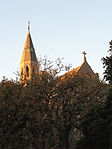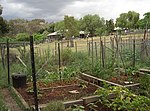Dights Falls
Geography of MelbourneUse Australian English from August 2014Victorian Heritage RegisterYarra River

Dights Falls is a rapid and weir on the Yarra River in Melbourne, Victoria, just downstream of the junction with the Merri Creek. At this point the river narrows and is constricted between 800,000-year-old volcanic, basaltic lava flow and a much older steep, silurian, sedimentary spur. The north side also contains abundant graptolite fossils in sedimentary sandstone.
Excerpt from the Wikipedia article Dights Falls (License: CC BY-SA 3.0, Authors, Images).Dights Falls
Main Yarra Trail Capital City Trail, Melbourne Abbotsford
Geographical coordinates (GPS) Address Nearby Places Show on map
Geographical coordinates (GPS)
| Latitude | Longitude |
|---|---|
| N -37.797222222222 ° | E 145.00083333333 ° |
Address
Dights Falls
Main Yarra Trail Capital City Trail
3067 Melbourne, Abbotsford
Victoria, Australia
Open on Google Maps









